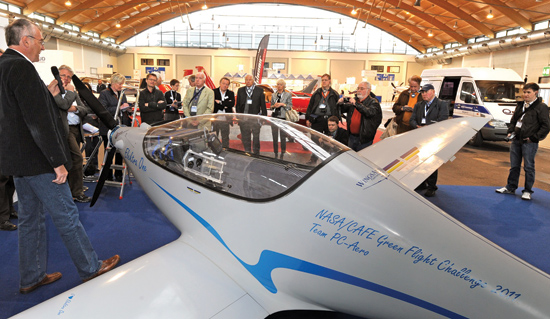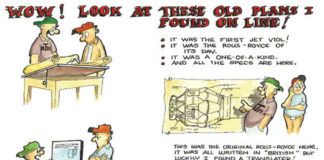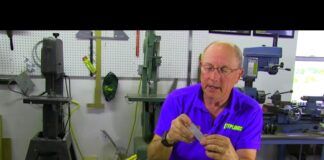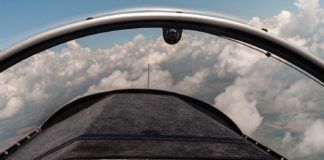Was this year’s symposium a turning point? Brien Seeley, president of the CAFE Foundation, the sponsoring organization for the event, certainly thinks so, and there was ample evidence to back up his assessment. With the introduction of 13 new electric, hybrid and biofueled competitors in the coming NASA/CAFE Green Flight Challenge, an international compendium of distinguished speakers, and some mind-bending breakthroughs in aerodynamics and propulsion, this year’s symposium certainly pointed in new directions for general aviation.
Why It’s Important
General aviation faces some real threats, partly because aviation itself is a small slice of the energy-use pie, all flying accounting for only 3% of the fossil fuels burned in making engines turn over, and private flying consuming a mere sliver of that slice. Consider the economics of refining a special batch of 100-octane low-lead fuel for a dwindling number of reciprocating engines, increasing numbers of states passing laws prohibiting the use of lead and aromatics in fuels, and alternatives such as biofuel and electric or fuel cell power become attractive-and possibly inevitable.
Other forces, such as the actual or perceived need to do something about climate change and global warming, public pressure against noisy airports and aircraft, and the rising costs and inconvenience of getting airborne will force general aviation to alternative paths.
While speakers such as Dr. Benjamin Santer spoke emphatically about the need to curtail our use of fossil fuels, the two dozen who followed had ample numbers of solutions that emphasized the innovation and ingenuity that could show us the alternative paths necessary for the future.

A diesel generator, three electric motors, three propellers, a Goldschmied propulsor (say what?) and two guys in space suits.
More Power
Presentations concerning energy storage devices were of immediate interest. Batteries, with their weight and limited energy, have impeded progress in a field where electric motors are becoming lightweight torque and power monsters. Still, progress is being made.
Eric Darcy, NASA Johnson Space Center battery expert, spoke about lithium-ion pouch cell designs for crewed applications, and explained commercial off-the-shelf (COTS) pouches being used in various crewed space missions. Expanding on last year’s talk about quality control at the manufacturing level, Darcy showed that COTS cells tested averaged one failure in 235 million.
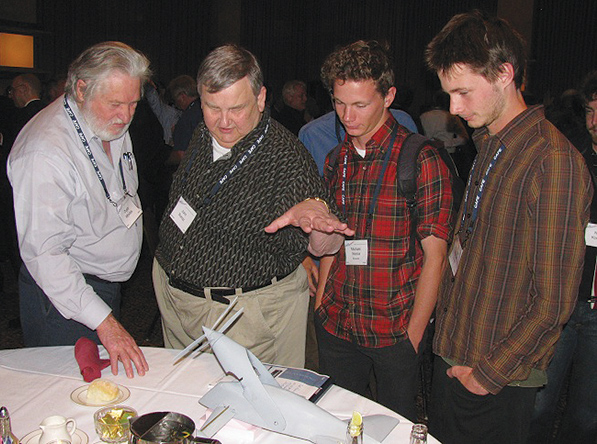
Dusty Rhodes (left) shows his flying motorcycle to airfoil guru John Roncz (next left).
Karl Young of Extreme Capacitors, Inc. compared battery performance with the claimed performance of his X-Cap double-layer supercapacitors, concluding that X-Caps are superior, and have the potential of $300 per kilowatt-hour prices, compared to $1500 per kW/hour for lithium batteries. Their best feature would be 1,000,000+ charge-recharge cycles, ensuring eternal energy storage.
Yueming Li and Ning Pan of UC Davis presented "The Current State of Supercapacitor Research," noting the traditional issue with capacitors: high power density but low energy density. Careful research in their lab has led them to carbon nanotube-based supercapacitors that give energy densities equal to those of lithium cells, but with far higher power densities. What do we mean by this? Power is what happens in sprints. A person, like a capacitor, can make a maximum effort for a short burst, but will then be done for the day. Energy is what happens in marathons. A battery can produce a lower level of power for an extended period, eventually exerting the same amount of energy the capacitor put out in a few seconds.
Bruce Katz of PolyPlus showed his company’s research in lithium-seawater and lithium-air batteries. His best so far: 1300 Watt-hours per kilogram and 700 Watt-hours per liter-a world record in November 2009. Katz anticipates energy densities approaching gasoline. This could come within two years for seawater based batteries, but lithium-air could be five years away, and full EV use might be two decades away-roughly the time it took Tesla to achieve its current state.
Oxis Energy’s Huw Hampson-Jones discussed "Next Generation Battery Technology" and showed his U.K. firm’s lithium sulfur battery, claiming 300 Wh/kg demonstrated, with 460 possible. Theoretically, the cells can reach 2700 Wh/kg. Testing is in progress, with a demonstration pack in a three-passenger car to be shown at the 2013 Geneva Motor Show.
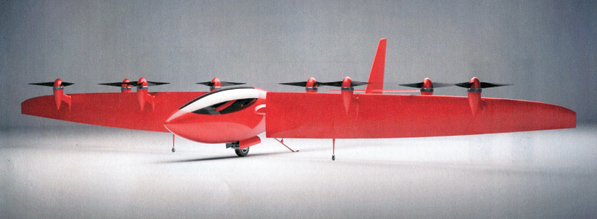
Joby Monarch’s eight motors and pivoting wings. It’s real and being built at Windward Performance for Joby Aviation.
Other Alternative Aircraft
If energy storage problems can be conquered, there is nothing to stop the deployment of the seemingly most wild-eyed visions in the engineer’s Jules Verne-like inventory. Many diverse efforts are pointed toward making the Personal Air Vehicle (PAV) and Suburban Air Vehicle (SAV) a practical reality.
Most extreme, but with current technology in mind, Murray Rozansky, treasurer for the Experimental Soaring Association, posited the idea: "Engines! We don’t need no stinkin’ engines!" His point, for the rest of us, is that sailplanes have outstanding aerodynamics and unparalleled efficiencies. Both of which will be necessary to make the best of transitional electric aircraft.
Others, for whom pure sailplane flight might not suffice, shared slightly more complicated concepts.
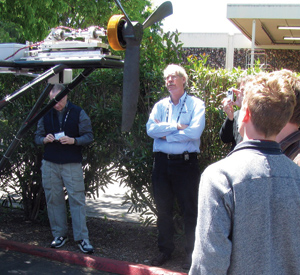
If you want to lure a bunch of electric airplane enthusiasts outside, promise to run your motor at lunch break (here the Joby motor).
JoeBen Bevirt of Joby Aviation, Joby Motors, Joby Robotics and Joby Energy, showed off a series of small motors that would power his eight-motor vertical takeoff and landing (VTOL) commuter, a single-place, highly automated way to avoid highway congestion that is now under construction.
Pietro Perlo of FIAT’s Research Center showed both road-based intelligent solutions and aerial alternatives to highway carnage-including his own company’s Flying Intelligent Autonomous Technology (FIAT) to take commuters above it all. One, The VTOL DiscoPlane, is an intriguing elliptical-wing biplane.
Robert Englar of Georgia Tech showed his concepts for electric short takeoff and landing (ESTOL) machines, which look like a cross between a Mignet Flying Flea and a Custer Channel Wing.
These visions will require a high degree of automation, furthered in Seeley’s SAV concept, allowing STOL aircraft to take off and land in "pocket airports" close to the flier’s home or ultimate destination, reducing pressure on existing highways and airports. This would require an automated and autonomous air traffic control system to relieve the National Highway System, built in 1956. Seeley’s model is based on a neocortex vital network, with the ability to respond to immediate and anticipated situations.
His system is aligned with NASA’s long-range vision of ubiquitous, on-demand, automated air travel for both people and goods (as developed at NASA’s October 2010 Aviation Unleashed Conference). He envisions very quiet SAVs whose passenger pods could transform into 25-mph mini-cars that would leave their wings at the pocket airport, stacked like shopping carts on a renewable energy electrical recharging system. The mini-pods would then drive on residential streets to cover the last mile or two to the destination.
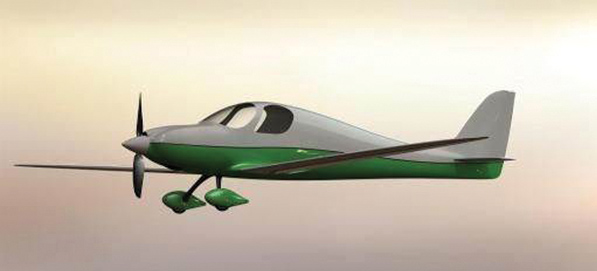
Greg Cole’s two-seat, gas-powered Goshawk economy motorglider for the GFC.
Alternative Motors
David Calley, CTO for Motor Excellence, says his job is to commercialize disruptive motor technologies. He seems to be succeeding, with a toroidally wound, transverse flux e-bike motor that requires only 5 minutes of coil winding, compared to the traditional motor that requires an hour of tedious and error-prone hand winding. The ME motor provides high torque at low rpm, ideal for aircraft. The company is also working with Lotus to demonstrate automotive applications this year.
Richard Glassock showed his multimodal hybrid powerplant for Unmanned Aerial System robotics, using a combination of internal combustion engine and electric motor in parallel to achieve best specific fuel consumption, and equivalent thrust to a straight IC setup, but with lower fuel flow. This is an interim step probably necessary until batteries or supercapacitors achieve a more tolerable weight-to-energy ratio.
Maintaining Control
Patrick McLaughlin of Mountain High Oxygen explained, "The target specification to my approach was to develop a high power-to-weight and size ratio multi-modal controller specifically for aviation applications." His controller, assembled from off-the-shelf (OTS) components with simple hand tools, can essentially "teach" itself to work with any motor, and act as a speed controller, stepper or servo, providing multiple functions normally found only in proprietary units.
Aerodynamic Smoothing
Ilan Kroo, professor at Stanford University, reviewed "Design Concepts for Small Aircraft," noting the environmental, efficiency, reliability and energy source benefits to be derived from aerodynamic enhancements such as motor/controller/propeller matching, quiet propeller design and efficient airframe development, which will lead to greater safety and utility in small aircraft.
NASA’s David Birkenstock discussed practical applications of Fabio R. Goldschmied’s theories, explaining how Goldschmied thrust augmented rather than retarded forward motion in the pressure recovery zone of a body of revolution. (See www.pressurethrust.com for a review of Birkenstock’s ideas. Goldschmied’s far-reaching theories are being examined and applied after 30 years. The CAFE Foundation library has his papers online.)
Birkenstock participated in a forum on Goldschmied propulsion along with Dennis Bushnell, John Roncz of Gemini Technologies and Voyager fame, and Sumon Sinha of Mississippi State. Roncz designed airfoils for 52 airplanes, two displayed in the Smithsonian, and Sinha designed a deturbulator that smooths airflow over the aft portion of sailplane wings, increasing lift-to-drag an average of 18%. He claimed over 100:1 lift:drag in one instance.
Because most total electric power systems are marginal for anything other than motorgliders at this point, the symposium brought together multi-discipline arrays of speakers to show how to squeeze the last erg of performance from a modern airplane, which, electric or not, must be the most efficient and energy-conserving creation possible.
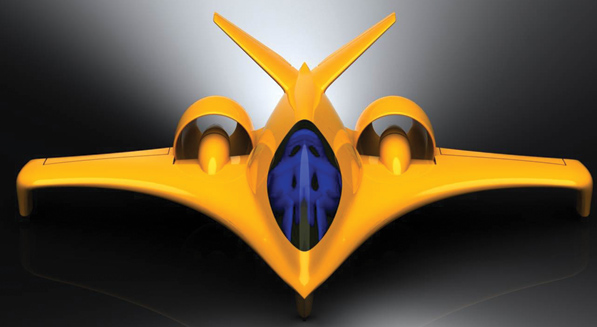
Seraph is a model-jet-generator-powered electric plane.
Networking
Furthering the idea that new autonomous aircraft will require air traffic control systems very different from current practice, Richard Glassock from Australia’s Queensland University of Technology explained how incremental autonomy would bring about a new norm in ATC. As things develop, such a system would allow remote operations with UAVs, in-flight restarts for soaring spies, stealth missions without endangering normal flight operations, and most importantly, automatic separation of all aerial vehicles in an area and automatic collision detection and avoidance, regardless of the aircraft type.
Jack Langelaan of the University of Pennsylvania shared ideas on autonomous flight, based on studies of terrain and mesoscale meteorology, to fly individual and group tasks with the best cross-country speeds and lowest fuel or energy usage. Employing techniques used with robots and UAV flight planning, Langelaan’s craft follow a complex interactive process to achieve their goals.
Such flight management must become as advanced as the new aircraft that will use these autonomous systems for maximum total flight efficiency. Every flight will become an energy management challenge much like the well-planned processes used by sailplane and aerobatic pilots. Advanced systems will lead to quicker, smoother less expensive flight.
Flight-Deck Planning
Ken Goodrich, of Dynamic Systems and Control at NASA, pondered the division of responsibilities between the airplane and the pilot. As aircraft become more automated, the areas of potential error change, and we must be aware of, and plan for, these new conflicts. Richard Glassock, Steve Williams (CAFE Board), Jack Langelaan and Damon Seeley joined him for a discussion on flight safety, haptic controls (the kind of feedback you get from a Wii paddle), pilot displays, and other authority, decision and command issues.
Georgia Tech’s Krish Ahuja showed that distributed small propellers may make less noise for the same thrust than one large propeller. This is ideal for electric aircraft, because as Ahuja points out, smaller motors don’t become less efficient. (Scaling effects for internal-combustion engines are a strong influence.) He even suggested replacing the prop entirely with alternative circulation technologies such as blowing air through trailing edge slots in the wing.
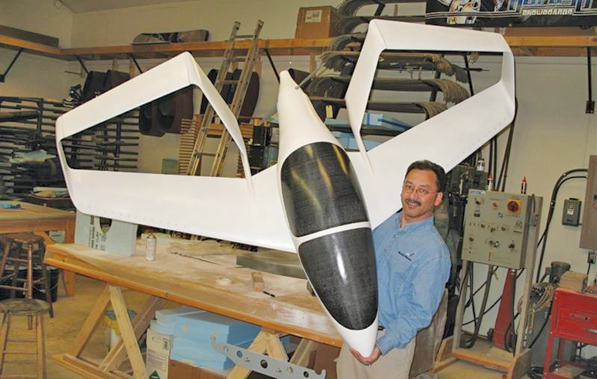
The top secret of the Synergy is revealed.
Mind Bender
Keynote speaker Dennis Bushnell, NASA chief scientist, guided the audience through "Emerging Technologies for Electric Aircraft: Frontiers of the Responsibly Imaginable." He examined energy equivalents for available resources, transforming today’s ground-based roads into aerial highways with the achievement of triple-redundant ATC, and radically changed flight patterns (big jets flying below 26,000 feet, for instance, thus getting rid of high, man-caused cirrus while reducing emissions). He discussed biofuels that don’t compromise food and water supplies, and looked at electric power and "exotic energetics."
Bushnell listed possible new sources of energy such as algae, which can produce biofuels and food. Halophyte algae can be produced on wastelands and with seawater, making potential sources abundant and inexpensive. Electric power can be produced from multiple sources, including atmospheric electrostatics. Distributing the sources will add to national security, something the current grid system does not do. He sees the possibilities in cold fusion and use of the weak nuclear force, something that Andrea Rossi in Italy has demonstrated can produce 2 billion times the energy output from chemical sources.
Although Bushnell painted much of the same current reality as other speakers, his comprehensive overview of current and potential technologies coupled with his broadly optimistic outlook in promoting plausible solutions drew a standing ovation.
With 28 presentations and forums from more than 30 presenters, and three theme dinners, the symposium offered a surfeit of food for thought-too much to absorb all at once. Luckily, I will have time to reflect and offer more detail at the CAFE Foundation blog over the next few months. Take a look at www.blog.cafefoundation.org.
The symposium leaves us with the tantalizing idea that much is possible that wasn’t even dreamed of a few years back. With inexpensive motors, new materials and techniques, the advance of microelectronics (GPS, for instance, common in consumer goodies such as cameras and cell phones), and the ability to make low-budget advances with even existing technologies, what experimenter could resist becoming a pioneer in a new direction in flight? Waiting for traditional aircraft manufacturers to buck the system will not make these things happen. Kit aircraft builders have been in the forefront before. Why not now?
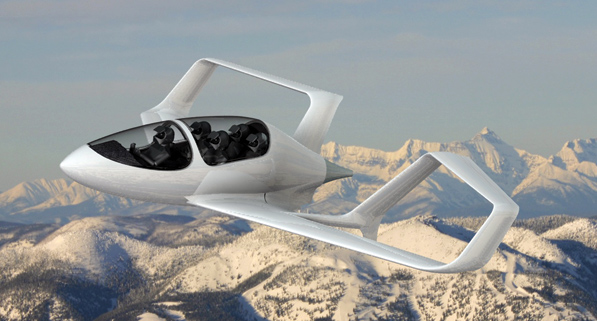
McGinnis’s Synergy is visualized over the peaks of Montana’s Whitefish Mountain Resort.
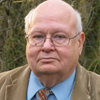
![]()
Dean Sigler has been a technical writer for30 years, with a liberal arts background and a Master’s degree in education. He writes the CAFE Foundation blog andhas spoken at the last two Electric Aircraft Symposia and at two Experimental Soaring Association workshops. Part of the Perlan Project, he is a private pilot, and hopes to get a sailplane rating soon.

